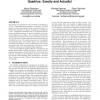Free Online Productivity Tools
i2Speak
i2Symbol
i2OCR
iTex2Img
iWeb2Print
iWeb2Shot
i2Type
iPdf2Split
iPdf2Merge
i2Bopomofo
i2Arabic
i2Style
i2Image
i2PDF
iLatex2Rtf
Sci2ools
COMPGEOM
2001
ACM
2001
ACM
Computing a 3-dimensional cell in an arrangement of quadrics: exactly and actually!
We present two approaches to the problem of calculating a cell in a 3-dimensional arrangement of quadrics. The first approach solves the problem using rational arithmetic. It works with reductions to planar arrangements of algebraic curves. Degenerate situations such as tangential intersections and self-intersections of curves are intrinsic to the planar arrangements we obtain. The coordinates of the intersection points are given by the roots of univariate polynomials. We succeed in locating all intersection points either by extended local box hit counting arguments or by globally characterizing them with simple square root expressions. The latter is realized by a clever factorization of the univariate polynomials. Only the combination of these two results facilitates a practical and implementable algorithm. The second approach operates directly in 3-space by applying classical solid modeling techniques. Whereas the first approach guarantees a correct solution in every case the second...
COMPGEOM 2001 | Degenerate Situations | Discrete Geometry | Planar Arrangements | Univariate Polynomials |
| Added | 23 Aug 2010 |
| Updated | 23 Aug 2010 |
| Type | Conference |
| Year | 2001 |
| Where | COMPGEOM |
| Authors | Nicola Geismann, Michael Hemmer, Elmar Schömer |
Comments (0)

